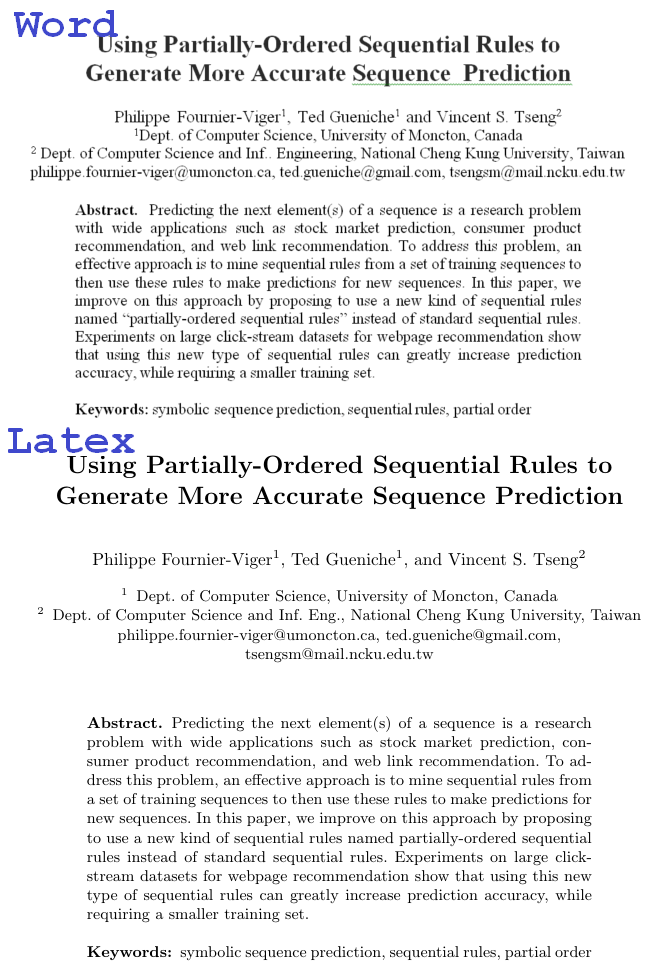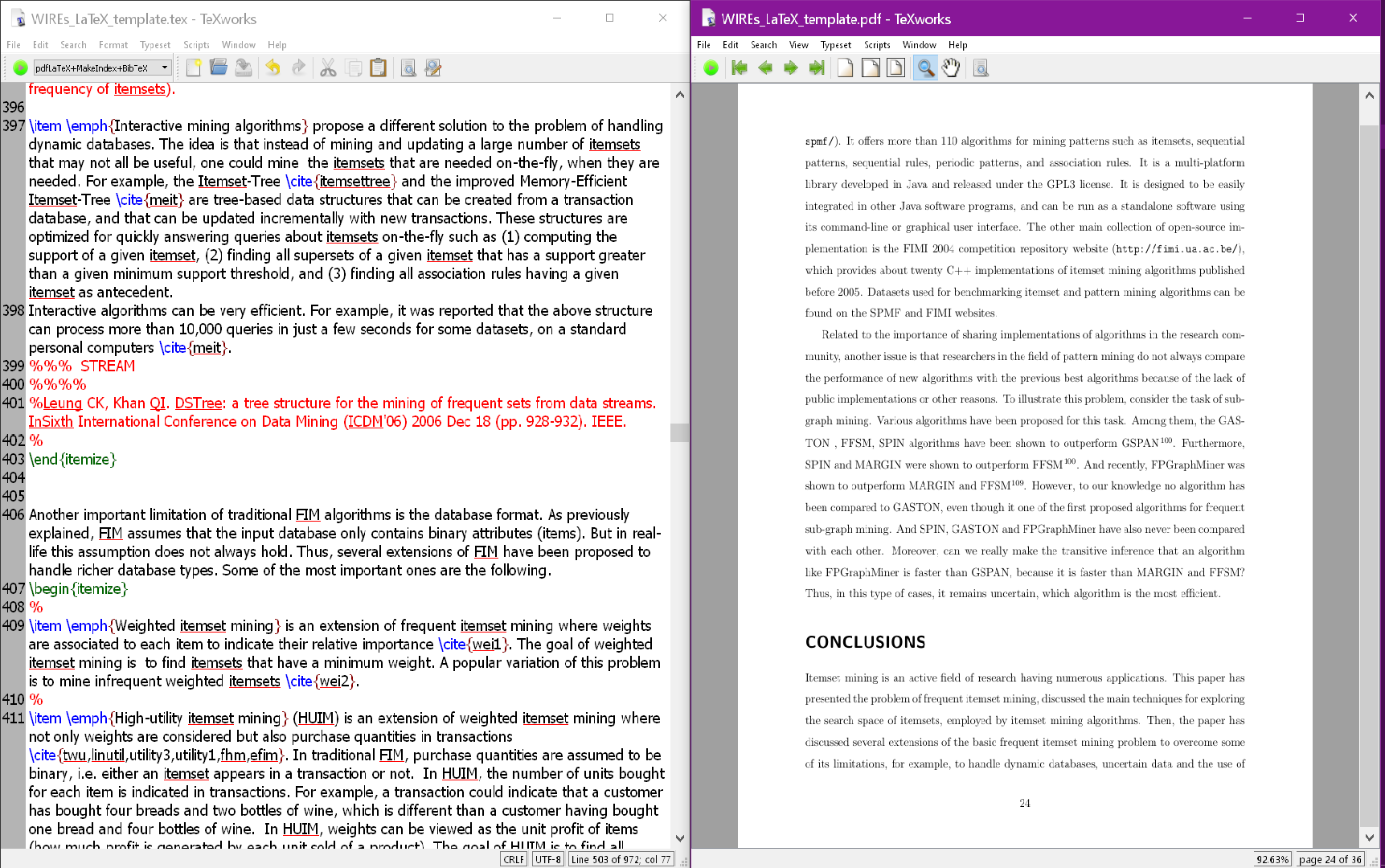Many researchers are using Microsoft Word for writing research papers. However, Microsoft Word has several problems or limitations. In this blog post, I will discuss the use of LaTeX as an alternative to Microsoft Word for writing research papers.
What is LaTeX?
LaTeX is a document preparation system, proposed in the 1980s. It is used to create documents such as research papers, books, or even slides for presentations.
The key difference between LaTeX and software like Microsoft Word is that Microsoft Word let you directly edit your document and immediately see the result, while using LaTeX is a bit like programming. To write a research paper using LaTeX, you have to write a text file with the .tex extension using a formatting language to roughly indicate how your paper should look like. Then, you can run the LaTeX engine to generate a PDF file of your research paper. The following figure illustrate this process:

In the above example, I have created a very simple LaTeX document (Example.tex) and then I have generated the corresponding PDF for visualization (Example.pdf).
Why using LaTeX?
There are several reasons why many researchers prefer LaTeX to Microsoft Word for writing research papers. I will explain some of them, and then I will discuss also some problems about using LaTeX.
Reason 1: LaTeX papers generally look better
LaTeX papers often look better than papers written using Microsoft Word. This is especially true for fields like computer science, mathematics and engineering where mathematical equations are used. To illustrate this point, I will show you some screenshots of a paper that I have written for the ADMA 2012 conference a few years ago. For this paper, I had made two versions: one using the Springer LNCS LaTeX template and the other one using the Springer LNCS Microsoft Word template.
This is the first page of the paper.

The first page is quite similar. The main difference is the font being used, which is different using LaTeX. Personally, I prefer the default LaTeX font. Now let’s compare how the mathematical equations appears in Latex and Word.

Here, we can see that mathematical symbols are more beautiful using LaTeX. For example, the set union and the subset inclusion operators are in my opinion quite ugly in Microsoft Word. The set union operator of Word looks too much like the letter “U”. In this example, the mathematical equations are quite simple. But LaTeX really shines when displaying more complex mathematical equations, for example using matrices.
Now let’s look at another paragraph of text from the paper to further compare the appearance of Word and LaTeX papers:

In the above picture, it can be argued that both LaTeX and Word papers look quite similar. For me, the big difference is again in the font being used. In the Springer Word template, the Times New Roman font, while LaTeX has its own default font. I prefer the LaTeX font. Also, I think that the URLs look better in LaTeX using the url package.
Reason 2: LaTeX is available for all platforms
The LaTeX system is free and available for most operating systems, and documents will look the same on all operating systems.
To install LaTeX on your computer you need to install a LaTeX distribution such as MikTeK ( https://miktex.org/ ). After installing LaTeX, you can start working on LaTeX documents using a text editor such as Notepad. However, it is more convenient to also install an editor such as TexWorks or WinShell. Personally, I use TexWorks. This is a screenshot of my working environment using TexWorks:

I will open my LaTeX document on the left window. Then, the right window will display the PDF generated by LaTeX. Thus, I can work on the LaTeX code of my documents on the left and see the result on the right.
If you want to try LaTeX without installing it on your computer, you can use an online LaTeX editor such as ShareLatex (http://www.sharelatex.org ) or OverLeaf. Using these editors, it is not necessary to install LaTeX on your computer. I personally sometimes use ShareLatex as it also has some function for collaboration (history, chat, etc.), which is very useful when working on a research paper with other people.
Reason 3: LaTeX offers many packages
Besides the basic functionalities of LaTeX, you can install hundreds of packages to add more features to LaTeX. If you use MikTek for example, there is a tool called the “MikTek package manager” that let you choose and install packages. There are packages for about everything from packages to display algorithms to packages for displaying chessboards. For example, here is some algorithm pseudocode that I have written in one of my recent paper using a LaTeX package called algorithm2e:

As you can see the presentation of the algorithm is quite nice. Doing the same using Word would be very difficult. For example, it would be quite difficult to add a vertical line for the “for” loop using Microsoft Word.
Reason 4: You don’t need to worry about how your document will look like
When writing a LaTeX document, you don’t need to worry about how your final document will look like. For example, you don’t need to worry about where the figures and tables will appear in your document or where the page breaks will be. All of this is handled by the LaTeX engine during the compilation of your document. When writing document, you only need to use some basic formatting instructions such as indicating when a new section starts in your document. This let you focus on writing.
Reason 5: LaTeX can generate and update your bibliography automatically
Another reason for using LaTeX is that it can generate the bibliography of a document automatically. There are different ways of writing a bibliography using LaTeX. One of the most common way is to use a .bib file. A .bib file provide a list of references that can be used in your document. Then, you can use these references in your .tex document using the \cite{} command and the bibliography will be automatically generated.
I will illustrate this with an example:

A), I have created a Latex document (a .tex file) where I cite a paper called “efim” using the LaTeX command \cite{efim}.
B) I have created a corresponding LaTeX bib file that provides bibliographical information about the “efim” paper.
C) I have generated the PDF file using the .tex file and the .bib file. As you can see, the \cite{} command has been replaced by 25, and the corresponding entry 25 has been automatically generated in the correct format for this paper and added to the bibliography.
The function for generating a bibliography using LaTeX can save a lot of time to researchers especially for documents containing many references such as thesis, books, and journal papers.
Moreover, once you have created a .bib file, you can reuse it in many different papers. And it is also very easy to change the style of your bibliography. For example, if you want to change from the APA style to the IEEE style, it can be done almost automatically, which saves lot of time.
In Microsoft Word, there is some basic tool for generating a bibliography but it provides much less features than LaTeX.
Reason 6: LaTeX works very well for large documents
LaTeX also provides many features that are useful for large documents such as Ph.D thesis and books. These features include generating tables of contents, tables of figures, and dividing a document into several files. Some of these features are also provided in Microsoft Word but are not as flexible as in LaTeX. I have personally written both my M.Sc. and Ph.D. thesis using LaTeX and I have saved a lot of time by doing this. I have simply downloaded the LaTeX style file from my university and then used it in my LaTeX document, and after that all my thesis was properly formatted according to the university style, without too much effort.
Problems of LaTeX
Now, let’s talk about the disadvantage or problems faced using LaTeX. The first problem is that there is a somewhat steep learning curve. LaTeX is actually not so difficult to learn but it is more difficult than using Word. It is necessary to learn various commands for preparing LaTeX documents. Moreover, some errors are not so easy to debug. However, the good news is that there exist some good places to ask questions and obtain answers when encountering problems with LaTeX such as Tex.StackExchange ( http://tex.stackexchange.com/ ). There also exist some free books such as the Not So Short Introduction To LaTeX that are quite good for learning LaTeX, and that I use as reference. Actually, although, there is a steep learning curve, I think that it is an excellent investment to learn to use LaTeX for researchers. Moreover, some journals in academia actually only accept LaTeX papers.
The second problem with LaTeX is that it is actually not necessary to use LaTeX for writing simple documents. LaTeX is best used for large documents or documents with complex layouts or for special needs such as displaying mathematical equations and algorithms. I personally use LaTeX only for writing research papers. For other things, I use Microsoft Word. Some people also use LaTeX for preparing slides using packages such as beamer, instead of using Powerpoint. This can be useful for preparing a presentation with lot of mathematical equations.
Conclusion
In this blog post, I have discussed the use of LaTeX for writing research papers. I hope that you have enjoyed this blog post.
—
Philippe Fournier-Viger is a professor of Computer Science and also the founder of the open-source data mining software SPMF, offering more than 120 data mining algorithms.





Pingback: Comparing Two LaTeX documents with Latexdiff | The Data Mining Blog